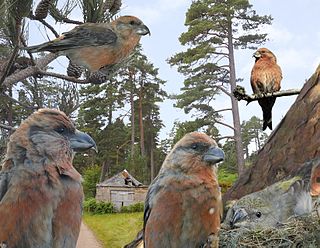
The Scottish crossbill is a small passerine bird in the finch family Fringillidae. It is endemic to the Caledonian Forests of Scotland, and is the only terrestrial vertebrate species endemic to the United Kingdom. The Scottish crossbill was confirmed as a unique species in August 2006, on the basis of having a distinctive bird song.

The parrot crossbill is a small passerine bird in the finch family Fringillidae. It breeds in pine forests in northern and northeastern Europe.

The red crossbill or common crossbill is a small passerine bird in the finch family Fringillidae. Crossbills have distinctive mandibles, crossed at the tips, which enable them to extract seeds from conifer cones and other fruits.

The two-barred crossbill or white-winged crossbill is a small passerine bird in the finch family Fringillidae. It breeds in the coniferous forests of North America and the Palearctic.

The Tortricidae are a family of moths, commonly known as tortrix moths or leafroller moths, in the order Lepidoptera. This large family has over 11,000 species described, and is the sole member of the superfamily Tortricoidea, although the genus Heliocosma is sometimes placed within this superfamily. Many of these are economically important pests. Olethreutidae is a junior synonym. The typical resting posture is with the wings folded back, producing a rather rounded profile.

The Archipini are a tribe of tortrix moths. Since many genera of these are not yet assigned to tribes, the genus list presented here is provisional.

Cydia succedana, or Gorse Pod Moth is a species of moth of the family Tortricidae. It is found in Europe and has been introduced to New Zealand.

The black-lyre leafroller moth is a tortrix moth species of the family Tortricidae.

Eurythecta is a genus of moths belonging to the subfamily Tortricinae of the family Tortricidae.
Harmologa is a genus of moths belonging to the subfamily Tortricinae of the family Tortricidae.

Planotortrix is a genus of moths belonging to the subfamily Tortricinae of the family Tortricidae.

Parienia is a genus of moths belonging to the subfamily Olethreutinae of the family Tortricidae. This genus was described by Edward Meyrick in 1881. It consists of only one species, Parienia mochlophorana, which is endemic to New Zealand.
Ctenopseustis servana is a species of moth of the family Tortricidae. It is found in New Zealand, where it has been recorded from the North Island and the Three Kings Islands.

Apoctena flavescens is a species of moth of the family Tortricidae. It is found in New Zealand, where it is found on both the North and South islands.

Epichorista emphanes, the beech leafroller, is a species of moth of the family Tortricidae. It is found in New Zealand.

Eurythecta curva is a species of moth of the family Tortricidae. It is found in New Zealand.
Eurythecta eremana is a species of moth of the family Tortricidae. It was first described by Edward Meyrick in 1884. is found in New Zealand. The habitat consists of swampy areas.
Eurythecta leucothrinca is a species of moth of the family Tortricidae. It is found in New Zealand. The habitat consists of montane to sub-alpine grasslands and coastal salt marshes.

Eurythecta robusta is a species of moth in the family Tortricidae. This species is endemic to New Zealand. It is classified as "At Risk, Naturally Uncommon" by the Department of Conservation.

Eurythecta zelaea is a species of moth of the family Tortricidae. It is found in New Zealand. It is endemic to dry herbfields in Otago and Canterbury.
















